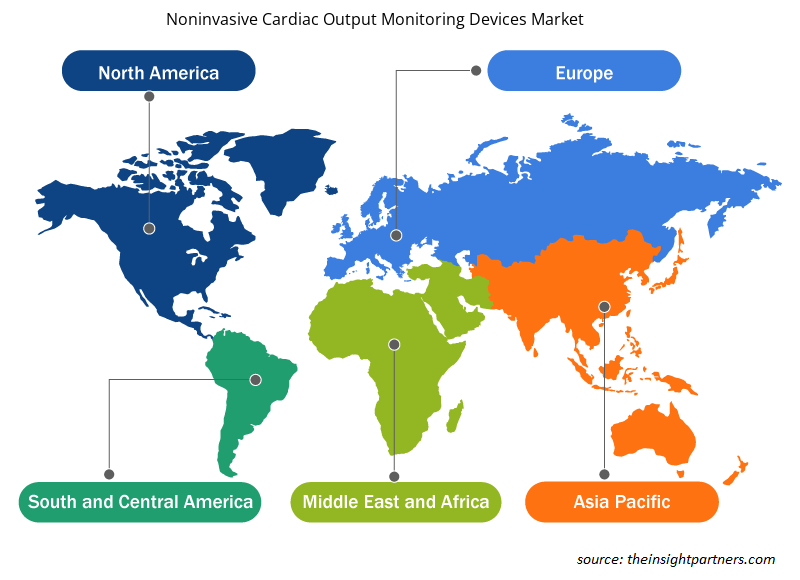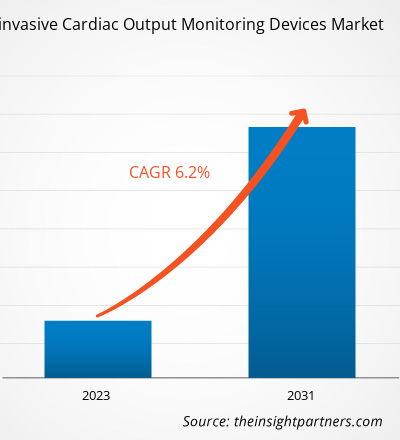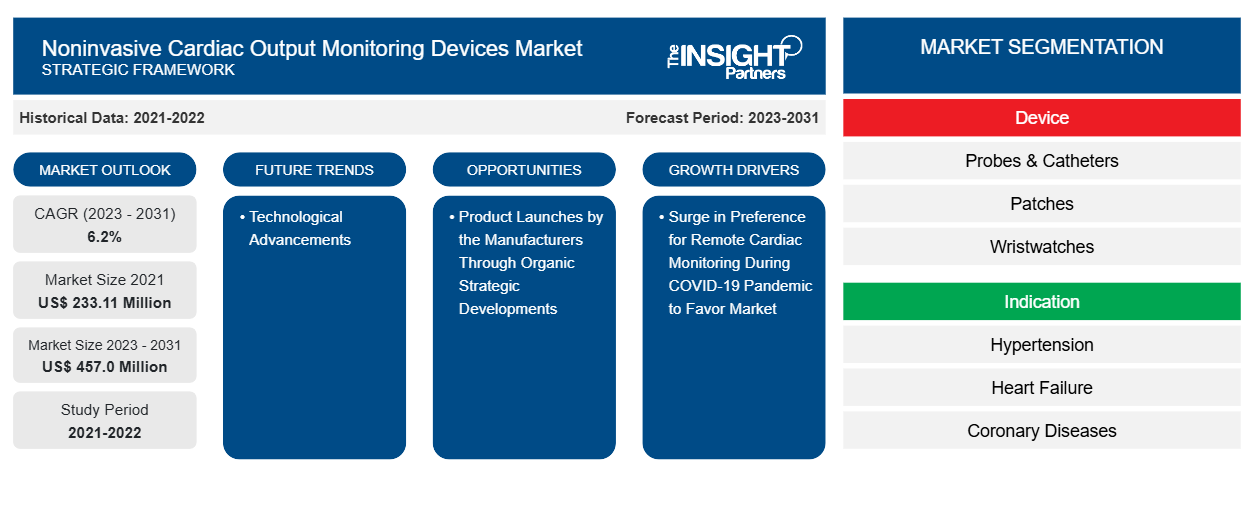El mercado de dispositivos de monitorización del gasto cardíaco no invasivo se valoró en 233,11 millones de dólares estadounidenses en 2021 y se espera que alcance los 457,0 millones de dólares estadounidenses en 2031. Se espera que el mercado registre una CAGR del 6,2 % entre 2023 y 2031. Es probable que los avances tecnológicos sigan siendo tendencias clave en el mercado de dispositivos de monitorización del gasto cardíaco no invasivo.
Análisis general del mercado de dispositivos de monitorización del gasto cardíaco no invasivos
La medición del gasto cardíaco (GC) es esencial en la práctica médica. En el pasado, la monitorización cardíaca invasiva era el tratamiento de referencia para el diagnóstico. Sin embargo, en los últimos años, los principales fabricantes de dispositivos médicos han desarrollado varios dispositivos de monitorización del gasto cardíaco no invasivos. Estos dispositivos son productos tecnológicamente avanzados que ofrecen soluciones alternativas a las poblaciones cardíacas reticentes a someterse a un tratamiento de diagnóstico cardíaco invasivo.
Descripción general del mercado de dispositivos de monitorización no invasiva del gasto cardíaco
La tecnología, la innovación y las soluciones tecnológicas inteligentes siguen influyendo positivamente en el crecimiento del mercado de dispositivos de monitorización del gasto cardíaco no invasivo de manera significativa. El avance tecnológico es una tendencia clave para el crecimiento del mercado. Los lanzamientos de nuevos productos por parte de los fabricantes a través de desarrollos estratégicos orgánicos brindarán oportunidades lucrativas para el crecimiento del mercado de dispositivos de monitorización del gasto cardíaco no invasivo durante el período de pronóstico.
Personalice este informe según sus necesidades
Obtendrá personalización en cualquier informe, sin cargo, incluidas partes de este informe o análisis a nivel de país, paquete de datos de Excel, así como también grandes ofertas y descuentos para empresas emergentes y universidades.
- Obtenga las principales tendencias clave del mercado de este informe.Esta muestra GRATUITA incluirá análisis de datos, desde tendencias del mercado hasta estimaciones y pronósticos.
Dispositivos de monitorización del gasto cardíaco no invasivos Factores impulsores y oportunidades del mercado
Aumento de la preferencia por la monitorización cardíaca remota durante la pandemia de COVID-19
Favorecer el mercado
Las tecnologías de monitorización cardíaca remota de pacientes ayudan a reformular el tratamiento de los trastornos cardíacos al hacer que la prestación de atención médica sea eficiente y accesible. Por ejemplo, las tecnologías de la nueva era, como los desfibriladores y marcapasos administrados a distancia, impulsan la demanda de atención cardíaca remota. La monitorización cardíaca remota está avanzando con una gestión eficiente de los datos del dispositivo, lo que da como resultado la adopción de dispositivos avanzados de monitorización cardíaca no invasiva. Además, hubo apoyo gubernamental para monitorear los signos vitales de forma remota en medio de la pandemia de COVID-19. Por ejemplo, en marzo de 2020, la USFDA anunció la autorización del uso ampliado de dispositivos para monitorear los signos vitales de los pacientes de forma remota. Permitir que los dispositivos cardíacos remotos se utilicen de forma remota puede ayudar a los proveedores de atención médica a acceder a información sobre los signos vitales de los pacientes mientras el paciente está en casa, lo que reduce la necesidad de visitas al hospital y minimiza el riesgo de exposición al nuevo coronavirus. Además, los principales fabricantes de dispositivos médicos han lanzado innovadores dispositivos de monitorización del gasto cardíaco no invasivo durante la pandemia de COVID-19. Por ejemplo, en mayo de 2020, Octagos Health, una empresa emergente de atención médica con sede en Houston, anunció el lanzamiento de una plataforma de software de monitorización remota de próxima generación para pacientes con dispositivos cardíacos implantados. El software Octagon permite a los profesionales sanitarios acceder a pacientes cardíacos, marcapasos y desfibriladores mediante un único portal. Además, el software simplifica la gestión de las transmisiones remotas y, al mismo tiempo, proporciona información y análisis de los pacientes en tiempo real en una plataforma segura y basada en la nube. Por lo tanto, el enfoque de los dispositivos de monitorización cardíaca remota contribuirá significativamente al crecimiento del mercado de dispositivos de monitorización del gasto cardíaco no invasivos.USFDA announced the allowance of expanded use of devices to monitor patients' vital signs remotely. Allowing remote cardiac devices to be used remotely can help healthcare providers access information about patients’ vital signs while the patient is at home, reducing the need for hospital visits and minimizing the risk of novel coronavirus exposure. Furthermore, key Octagos Health, a Houston-based healthcare startup company, announced the launch of a next-generation remote monitoring software platform for patients with implanted cardiac devices. The Octagon software allows healthcare professionals access to cardiac patients, pacemakers, and defibrillators using one portal. Also, the software simplifies the management of remote transmissions and simultaneously provides real-time patient insights and analytics in a secure and cloud-based platform. Therefore, the remote cardiac monitoring devices approach will contribute significantly to the noninvasive cardiac output monitoring devicesmarket growth.
Avances tecnológicos
Los avances tecnológicos han animado a los fabricantes de dispositivos médicos a diseñar productos innovadores. Las tecnologías emergentes ofrecen alternativas eficaces a la monitorización cardíaca tradicional, creando alertas para los pacientes con riesgo de enfermedad cardiovascular. La telemetría cardíaca móvil (MCT) es un ejemplo de un producto de monitorización cardíaca tecnológicamente avanzado. El sistema MCT ayuda a controlar las condiciones cardíacas de los pacientes cardíacos. Los pacientes llevan un pequeño sensor y monitor durante todo el día. Siempre que se produce un evento cardíaco, el MCT envía los datos a un sistema central para su análisis y respuesta. El sistema genera un informe que contiene gráficos y tendencias y lo comparte con los médicos del paciente para que tomen medidas adicionales. Los sistemas MCT pueden analizar cada latido del corazón y detectar irregularidades en las condiciones normales de un paciente, seguido de iniciar una respuesta de emergencia inmediata, lo que los convierte en una de las opciones más preferidas para la monitorización cardíaca. Por lo tanto, la adopción de estos dispositivos de monitorización del gasto cardíaco no invasivos tecnológicamente avanzados satisface las necesidades de atención médica de un paciente, lo que impulsa el crecimiento del mercado de dispositivos de monitorización del gasto cardíaco no invasivos.
Lanzamientos de productos por parte de los fabricantes a través de desarrollos estratégicos orgánicos
Los fabricantes están invirtiendo en el diseño de dispositivos innovadores de monitorización no invasiva del gasto cardíaco para conectar mejor a los hospitales con los pacientes cardíacos. A continuación, se presentan algunos avances de los fabricantes.
- En junio de 2021, Max Healthcare lanzó un marco de monitoreo de pacientes integrado con un dispositivo impulsado por inteligencia artificial (IA), que se afirma que es el primero en el país. Max Healthcare es uno de los proveedores de atención médica más grandes de la India, con más de 15 hospitales de superespecialidades, diagnósticos y servicios integrados de atención domiciliaria. Ha lanzado el servicio de monitoreo de pacientes impulsado por IA en colaboración con un proveedor de soluciones de salud digital llamado MyHealthcare. El ecosistema Max MyHealth+, creado en colaboración con MyHealthcare, ha integrado monitores de presión arterial, dispositivos de ECG y frecuencia cardíaca y dispositivos de monitoreo de azúcar en sangre.
- En mayo de 2021, VitalConnect, Inc., un proveedor líder de tecnología de biosensores para monitoreo remoto y en el hospital, lanzó la solución de telemetría cardíaca móvil (MCT) VitalPatch RTM. Es la única solución de monitoreo cardíaco disponible con una plataforma flexible y programable que cubre múltiples necesidades de monitoreo cardíaco. La plataforma, disponible exclusivamente en VitalConnect, permite la detección continua y en tiempo real de arritmias cardíacas mientras se miden simultáneamente los parámetros fisiológicos del paciente.
Es probable que estas actividades estratégicas brinden oportunidades lucrativas para que el mercado de dispositivos de monitoreo del gasto cardíaco no invasivo impulse la innovación durante el período de pronóstico.
Dispositivos de monitorización no invasiva del gasto cardíaco
Análisis de segmentación de informes de mercado
Los segmentos clave que contribuyeron a la derivación del análisis del mercado de dispositivos de monitoreo del gasto cardíaco no invasivo son el dispositivo, la indicación y el usuario final.
- Según el dispositivo, el mercado de dispositivos de monitorización no invasiva del gasto cardíaco se segmenta en sondas y catéteres, parches y relojes de pulsera. El segmento de sondas y catéteres tuvo la mayor participación de mercado en 2023.
- Por indicación, el mercado está segmentado en hipertensión, insuficiencia cardíaca, enfermedades coronarias, isquemia e infarto de miocardio, arritmias, problemas congénitos y otros. El segmento de hipertensión tuvo la mayor participación del mercado en 2023.
- Por usuario final, el mercado está segmentado en hospitales, centros de servicios de emergencia, atención domiciliaria y otros. El segmento de hospitales tuvo la mayor participación de mercado en 2023.
Análisis de la cuota de mercado de los dispositivos de monitorización no invasiva del gasto cardíaco por geografía
El alcance geográfico del informe de mercado de dispositivos de monitoreo de gasto cardíaco no invasivo se divide principalmente en cinco regiones: América del Norte, Asia Pacífico, Europa, Medio Oriente y África, y América del Sur y Central.
América del Norte dominó el mercado de dispositivos de monitorización del gasto cardíaco no invasivo. En el mercado norteamericano, Estados Unidos representa una cuota de mercado considerable. La presencia de los principales fabricantes de dispositivos médicos en Estados Unidos y el lanzamiento de productos tecnológicamente avanzados por parte de los fabricantes se encuentran entre los factores más influyentes responsables del crecimiento del mercado. Se prevé que Asia Pacífico registre la CAGR más alta en los próximos años.
Dispositivos de monitorización no invasiva del gasto cardíaco
Perspectivas regionales del mercado de dispositivos de monitorización del gasto cardíaco no invasivo
Los analistas de Insight Partners explicaron en detalle las tendencias y los factores regionales que influyen en el mercado de dispositivos de monitorización del gasto cardíaco no invasivo durante el período de pronóstico. Esta sección también analiza los segmentos y la geografía del mercado de dispositivos de monitorización del gasto cardíaco no invasivo en América del Norte, Europa, Asia Pacífico, Oriente Medio y África, y América del Sur y Central.

- Obtenga datos regionales específicos para el mercado de dispositivos de monitoreo de gasto cardíaco no invasivo
Alcance del informe de mercado sobre dispositivos de monitorización del gasto cardíaco no invasivo
| Atributo del informe | Detalles |
|---|---|
| Tamaño del mercado en 2021 | US$ 233,11 millones |
| Tamaño del mercado en 2031 | US$ 457,0 millones |
| CAGR global (2023 - 2031) | 6,2% |
| Datos históricos | 2021-2022 |
| Período de pronóstico | 2023-2031 |
| Segmentos cubiertos | Por dispositivo
|
| Regiones y países cubiertos | América del norte
|
| Líderes del mercado y perfiles de empresas clave |
|
Densidad de actores del mercado de dispositivos de monitorización no invasiva del gasto cardíaco: comprensión de su impacto en la dinámica empresarial
El mercado de dispositivos de monitorización no invasiva del gasto cardíaco está creciendo rápidamente, impulsado por la creciente demanda de los usuarios finales debido a factores como la evolución de las preferencias de los consumidores, los avances tecnológicos y una mayor conciencia de los beneficios del producto. A medida que aumenta la demanda, las empresas amplían sus ofertas, innovan para satisfacer las necesidades de los consumidores y aprovechan las tendencias emergentes, lo que impulsa aún más el crecimiento del mercado.
La densidad de actores del mercado se refiere a la distribución de las empresas o firmas que operan dentro de un mercado o industria en particular. Indica cuántos competidores (actores del mercado) están presentes en un espacio de mercado determinado en relación con su tamaño o valor total de mercado.
Las principales empresas que operan en el mercado de dispositivos de monitorización del gasto cardíaco no invasivo son:
- Baxter,
- Bio-ritmo,
- Atención sanitaria de GE,
- Philips NV, una empresa de telecomunicaciones de renombre mundial.
- Abad,
- Deltex Medical Limited,
Descargo de responsabilidad : Las empresas enumeradas anteriormente no están clasificadas en ningún orden particular.

- Obtenga una descripción general de los principales actores clave del mercado de dispositivos de monitoreo de gasto cardíaco no invasivo
Dispositivos de monitorización no invasiva del gasto cardíacoNoticias del mercado y novedades recientes
El mercado de dispositivos de monitorización no invasiva del gasto cardíaco se evalúa mediante la recopilación de datos cualitativos y cuantitativos posteriores a la investigación primaria y secundaria, que incluye publicaciones corporativas importantes, datos de asociaciones y bases de datos. A continuación, se incluye una lista de los avances del mercado:
- En enero de 2021, OMRON Healthcare, Inc. lanzó su primer servicio de monitoreo remoto de pacientes en el CES 2021, junto con nuevas herramientas de salud digital, para impulsar la comunicación entre pacientes y médicos y garantizar el manejo activo de la hipertensión. OMRON presentó el primer tensiómetro portátil, así como el primer tensiómetro con ECG incorporado en los últimos tres años; con las innovaciones, continúa transformando el mercado mundial de la salud cardíaca y respalda su misión de alcanzar cero ataques cardíacos y accidentes cerebrovasculares.
Informe de mercado sobre dispositivos de monitorización del gasto cardíaco no invasivo y resultados
El informe “Tamaño y pronóstico del mercado de dispositivos de monitoreo del gasto cardíaco no invasivo (2021-2031)” proporciona un análisis detallado del mercado que cubre las siguientes áreas:
- Tamaño del mercado de dispositivos de monitorización del gasto cardíaco no invasivo y pronóstico a nivel mundial, regional y nacional para todos los segmentos clave del mercado cubiertos bajo el alcance
- Tendencias del mercado de dispositivos de monitorización del gasto cardíaco no invasivo, así como dinámica del mercado, como impulsores, restricciones y oportunidades clave
- Análisis detallado de las cinco fuerzas de Porter y PEST y FODA
- Análisis del mercado de dispositivos de monitorización del gasto cardíaco no invasivo que abarca las tendencias clave del mercado, el marco global y regional, los principales actores, las regulaciones y los desarrollos recientes del mercado
- Panorama de la industria y análisis de la competencia que abarca la concentración del mercado, análisis de mapas de calor, actores destacados y desarrollos recientes para el mercado de dispositivos de monitoreo de gasto cardíaco no invasivo
- Perfiles detallados de empresas
- Análisis histórico (2 años), año base, pronóstico (7 años) con CAGR
- Análisis PEST y FODA
- Tamaño del mercado, valor/volumen: global, regional y nacional
- Industria y panorama competitivo
- Conjunto de datos de Excel
Informes recientes
Testimonios
Razón para comprar
- Toma de decisiones informada
- Comprensión de la dinámica del mercado
- Análisis competitivo
- Información sobre clientes
- Pronósticos del mercado
- Mitigación de riesgos
- Planificación estratégica
- Justificación de la inversión
- Identificación de mercados emergentes
- Mejora de las estrategias de marketing
- Impulso de la eficiencia operativa
- Alineación con las tendencias regulatorias





















 Obtenga una muestra gratuita para - Mercado de dispositivos de monitorización no invasiva del gasto cardíaco
Obtenga una muestra gratuita para - Mercado de dispositivos de monitorización no invasiva del gasto cardíaco